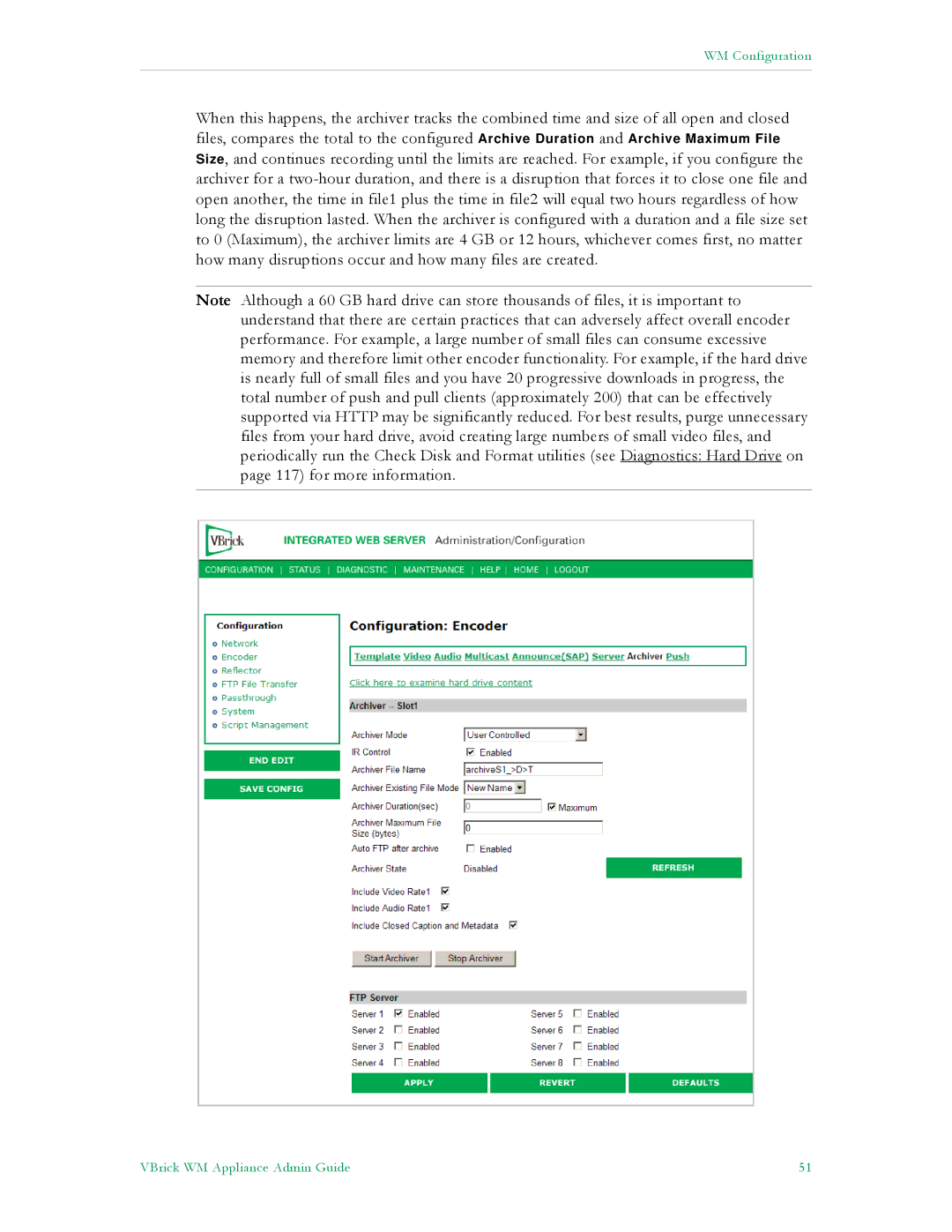VB4000-5000-6000 Series Network Video Appliances
Copyright
Contents
Status
SDI Configuration
Maintenance
Diagnostics
Maintenance Mode
WM Templates
Index
Stream Prioritization
Organization
WM Admin Guide
Getting the Best Video
Getting Help
Printer-Friendly
Font Conventions
Preface
System Requirements for Windows Media Player
Overview
Topics in this chapter
Standard Feature Encoder Reflector
Standard Features
Typical VBrick Applications
Http TCP
VBricks Streaming Ecosystem
Application Description
Unicasting
Multicasting
Reflecting
VBrick Reflecting
Push Reflecting
Reflecting from VBrick Appliances
Push Reflecting from a Windows Media Server
Pull Reflecting
Pull Reflector Type
MBR Output Streams
Using Multiple Bit Rate Streams
Other Considerations
Output Description
Configurable Input/Output Stream Rates WM Output Streams
Shared Video Settings Independent Video Settings
MBR Output Settings
HTTP/RTSP
MBR Groups
Shared Audio Settings Independent Audio Settings
MBR Troubleshooting
Using On Demand Playback
Mixed Model Appliances
Optimizing System Performance
Archiver/Recorder Functionality
Archiver and Recorder Functionality
VBrick Systems, Inc
WM Configuration
Configuration Network Ethernet
Configuration Network
Numbers or hyphens
Domain Name Server
Network Time Synchronization
Configuration Network Routing
WM Configuration
Configuration Network Management
Configuration Encoder Template
Configuration Encoder
Template Name Description
LAN
Configuration Encoder Video
Svid
Windows Media Encoder Video -- Slot1
VBrick Systems, Inc
Reduces the saturation
Settings to allow this Tools Options Security Run Script
Video Rate1 Video Rate2 Video Rate3
Video Template Settings -- Slot1 Video Rate1
Video Rate1 Video Rate2 Video Rate3
WM Configuration
Configuration Encoder Audio
Audio Template Settings
Stereo Mono
Bit Rate and Sample Frequency
Configuration Encoder Multicast
Windows Media Encoder Multicast -- Slot1
NSC File Information -- Slot1
Multicast Playback
Configuration Encoder Announce SAP
Windows Media Announce Common Information -- Slot1
Bit mask. This string is simply another keyword you can use
Announce Program Guide SAP for Multicast -- Slot1
Configuration Encoder Server
Http
Windows Media Encoder Server -- Slot1
Http URL
Rtspu
Rtspu URL
Rtsp UDP
Unicast Playback
Announce Http and Rtspu Server
Rtspu SAP
Http SAP
Rtsp URL
Announce External Server -- Slot1
ASX Rollover
Creating Publishing Points on Windows Media Servers
Creating Publishing Points
Creating Publishing Points on Helix Universal Servers
Creating Non-Authenticated Push Publishing Points
Creating Pull Publishing Points
Configuration Encoder Archiver
WM Configuration
Firmware
Windows Media Archiver -- Slot1
WM Configuration
Progressive Download
FTP Server Enable
Http Push Slot1
Configuration Encoder Push
VBrick Systems, Inc
Configuration Reflector
Push Receiver
Configuration Reflector Source
Pull Receiver
Microsoft Server on-demand
ASX
Pulling VOD Files from a Microsoft WM Server
Pulling MBR Streams
Configuration Reflector Announce SAP
Configuration Reflector Multicast
Configuration Reflector Server
Configuration Reflector Archiver
Configuration Reflector Push
Configuration Jpeg
Jpeg Configuration
Jpeg Capture Constraints
Jpeg FTP Configuration
Configuration FTP File Transfer Servers
Configuration FTP File Transfer
Model Jpeg Configuration Max Clients †
FTP Server
FTP Status
Configuration FTP File Transfer Transfers
Hard Drive Status
Configuration Passthrough
FTP Queue Operation
Passthrough State Responder
Configuration Passthrough COM1
Passthrough State Initiator
WM Configuration
Configuration Passthrough COM2
Configuration System
Configuration System General
System
Front Panel LCD Display
Configuration System Snmp Traps
Program Files\VBrick\VB6000\Download\ReleaseVxxxxxx
Number Event Description
Configuration System Security
Improving Security
Page
Configuration Script Management Event Triggering
Configuration Script Management
Run Scripts Using IWS
VBrick Systems, Inc
Run Scripts Using Event Triggers
Run Scripts Using the IR Remote Control
Sample Script
Scripting Notes
Configuration Script Management Auto Configuration
URL
VBrick Systems, Inc
Introduction
SDI Configuration
Configuration Encoder Video Configuration Encoder Audio
Video Limitations with SDI Video Input
SDI Limitations
Audio Limitations with SDI Video Input and SDI Audio Input
VBrick Systems, Inc
Status System Information
Status
Status Network Status Codec
Status Network Status
General
Interface
Status Network Status Routing
Status Network Status Network Time
Status Encoder Status
PLX Eeprom
Video
Close Captioning
Audio
Status Reflector Status General
Status Reflector Status
Multicast
Push Receive
Status Jpeg Status
VBrick WM Appliance Admin Guide 101
Status Hard Drive General Status Hard Drive Archiver
Status Hard Drive
VBrick WM Appliance Admin Guide 103
Status Server Status General
Status Server Status
Status Server Status Encoder Details
HTTP/RTSP Server
Status Server Status Reflector Details
Status Push Status
Http Push Status
Status FTP Server Status Status System Log
Status System Log Config
Status System Log System Event
Status System Log System Info
Status System Log Traps
Status User Information Main Board
Status User Information
Status User Information Slot1
112
Diagnostics Network Tests Ping Test
Diagnostics Network Tests
PDU
Diagnostics Network Tests Trace Route Test
Trace Route Test Results
Diagnostics Device Test
When done, reset Configured Operational Mode to Run
Diagnostics Hard Drive
118
Maintenance Device Information
Maintenance
Maintenance Read/Write Configuration
Maintenance Default All Configuration
Maintenance Read/Write Read From Device
Read Configuration Data from Device
Sample VBrick Configuration File
Maintenance Read/Write Write To Device
Write Configuration Data to Device
Maintenance Usernames & Passwords
124
User Level Default User Name Default Password Authority
Maintenance Usernames & Passwords Change SNMPv3 Passwords
126
Maintenance Mode
Maintenance Mode Indicators
Maintenance Mode Features
Maintenance Mode Limitations
Command Description Entry
Maintenance Mode CLI Operation
Subnet mask associated with
WM Templates
Best Quality
Video Encoder Parameter Setting
CBR/CFR
Cable/DSL-300K, High Motion
Audio Encoder Parameter Setting
Cable/DSL-128K, High Motion
Cable/DSL-300K, Low Motion
Cable/DSL-128K, Low Motion
Security & Surveillance
Modem 56K
Audio Channels Mono L +R Bit Rate 8000 Sample Frequency KHz
Stream Prioritization
Stream Prioritization
Bitrate Constrained
Non Bitrate Constrained
Example 1 Priority List
Example 2 Redundant List
For Group Serving
How the WM Appliance Creates Priority Lists
For Archiving, and Pushing to or Pulling from a WM Server
Example 4 Sliding Window Behavior
Safe Group Configurations
Configuring Groups
Index
Initiator
Device Test Network Tests
144

